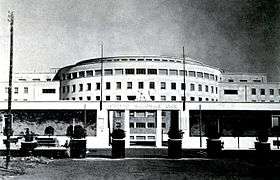Istituto Luce

The Istituto Luce (translation: "Light Institute", with Luce being the acronym for "L’ Unione Cinematografica Educativa", i.e. "The Educational Film Union") was an Italian corporation, created in 1924 during the Fascist era.
The Institute, based in Rome, was involved in the production and distribution of films and documentaries intended for being screened in cinemas. Famous for having been a powerful propaganda tool of the fascist regime, it is considered as the oldest public institution devoted to production and distribution of cinematographic materials for didactic and informative purposes in the world.[1][2][3]
History and profile

Istituto Luce was founded in 1924 as a stock company, and then Benito Mussolini through the Royal Decree Law no. 1985 of 5 November 1925 ruled it as non-profit "moral institution" governed by public law.[4]
In July 1925 the Presidency of the Council of Ministers branched out a circular to the Ministers of Interior, Education, Economy and Colonies asking them to use exclusively Istituto Luce for their educational and propaganda purposes.[4]
In 1927 it created the newsreel Giornale Luce, intended to be screened for duty in all Italian cinemas before the screening of their films.[4]
In 1935, the Istituto Luce established the Ente Nazionale Industrie Cinematografiche (ENIC), a branch dealing with film production: one of the first films produced was the 1937 blockbuster Scipio Africanus: The Defeat of Hannibal by Carmine Gallone. In 1936 the Institute ceases to depend directly on the prime minister and went under the MinCulPop.[4]
After the war the company continued to engage in production of numerous documentaries and films (directed, among others, by Pupi Avati, Marco Bellocchio, Claude Chabrol, Liliana Cavani, Mario Monicelli, Ermanno Olmi, Ettore Scola). In 2009 the company was merged with Cinecittà Holding SpA, setting up a joint stock company: Cinecittà Luce SpA, which in 2011 was renamed Istituto Luce Cinecittà.[5]
As of July 2012, a large collection of movies (about 30,000) was made available to the public through a YouTube channel, thanks to an agreement with Google .[6]
Notes
- ↑ Ernesto G. Laura. Le stagioni dell'Aquila. Storia dell'Istituto Luce. Ente dello Spettacolo, 2000.
- ↑ Michela Ardizzoni, Chiara Ferrari. Beyond Monopoly: Globalization and Contemporary Italian Media. Rowman & Littlefield, 2010. ISBN 0739128515.
- ↑ Elisa della Barba (28 June 2013). "Luce in the Unesco Memory of the World". Swide Magazine. Retrieved 14 November 2015.
- 1 2 3 4 Daniela Manetti. Un'arma poderosissima. Industria cinematografica e Stato durante il fascismo 1922-1943. FrancoAngeli, 2012. ISBN 8856846586.
- ↑ Alessandro Gilleri, Pierpaolo Bisleri. Lo spettacolo va in scena. Nozioni di organizzazione e scenotecnica dello spettacolo. FrancoAngeli, 2014. ISBN 8891704857.
- ↑ Silvio Gulizia (5 July 2012). "50 anni di Istituto Luce disponibili su YouTube". Wired. Retrieved 14 November 2015.
Further reading
- Mino Argentieri. L'occhio del regime. Informazione e propaganda nel cinema del fascismo. Vallecchi, 1979.
- Amedeo Benedetti. "Istituto Luce" in Il Cinema documentato. Cineteche, Musei del Cinema e Biblioteche cinematografiche in Italia, Genova, Cineteca D.W. Griffith, 2002, pp. 130–135.
- Amedeo Benedetti. "L'Istituto Luce di Roma". Insegnare, n. 5, May 2005. pp. 47–48.
- Federico Caprotti. "Information management and fascist identity: newsreels in fascist Italy". Media History 11(3): 177-191, 2005.
- E.A. Cicchino. Il Duce attraverso il Luce. Mursia. ISBN 9788842540427.
- Stefano Mannucci. Luce sulla guerra. La fotografia di guerra tra propaganda e realtà. Italia 1940-45. Nuova Arnica Editrice, 2007.
- Alessandro Sardi. Cinque anni di vita dell'Istituto Nazionale L.U.C.E.. Istituto Nazionale Luce, 1929.
- Felix Monguilot Benzal. "L’Istituto Luce nella guerra civile spagnola". Cinemasessanta, n.301. Città del Sole Edizioni, July – September 2009. pp. 58 – 69.
External links
| Wikimedia Commons has media related to Istituto Luce. |